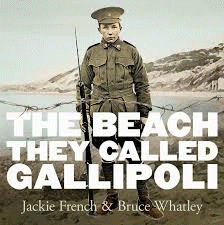The Beach They Called Gallipoli
Jackie French
Bruce Whatley
hbk., 32pp., RRP $A24.99
9780732292263
On April 23, 1915 on a beach on the Gallipoli Peninsula, seagulls swooped as fish flapped silver in the nets… a peaceful, tranquil scene.
But it was to be the last day of peace for that Turkish beach for a long time for on April 24, 1915 the ships came. And less than twenty four hours later, blood-stained foamed fringed the grey waves of a grey sea under a grey sky. For eight, long tragic months the conflict lasted as more ships brought more men and took away the broken bodies of the wounded, while leaving many more who would never leave this beach and its sentinel cliffs. “A land with few names had new names now: Anzac Cove, Quinn’s Post, Rhododendron Ridge, The Apex, Farm and Lone Pine.” Names etched into our history along with the courage, the compassion and the comradeship that we associate with them.
On December 21, 1915 the beach was again silent and empty, a tranquil place. Perhaps the seagulls and the fish had not yet returned, but the waves still rolled in onto the shore, just as they had done for months, years, decades, centuries. But months, years, decades, a century on we remember… Lest We Forget
Among the plethora of publications being written and released to commemorate the centenary of the events of April 25, 1915, this is a standout. By focusing on the place, Jackie brings range of perspectives about the people – the fishermen, the many nationalities who fought and those who defended. The blood that was shed mixes and mingles into a story of a battle with no heroes or winners – just people and the futility of war.
Superbly illustrated by Bruce Whatley with collages of photos, paintings, drawings, diagrams, artefacts, symbols and flags, it is a masterful insight into the campaign – its before, during and after. The sounds and sights and smells are brought to life through the skilful selection and arrangement of the vignettes that emphasise that while the place shaped the events, it is the people who created and encountered them and their consequences. There is no favouritism – it is written and illustrated as though the landscape is the observer witnessing men from everywhere trying to master it – as though that were ever going to be possible.
While such rich imagery leaves little to the imagination, it inspires the imagination. This was not the remote-control driven warfare that invades television news bulletins today – this was face-to-face conflict of a type that breeds the legends that have endured for so long. And all the while, the waves lap on the beach.
Jackie French and Bruce Whatley, as author and illustrator, are a match made in heaven. This could be one of their most important collaborations yet and I predict it will be high on the awards lists this year. It is an essential resource in your commemoration collection.
Inside History has an interview with Jackie and Bruce about the reasons behind the book and the research that went into it go to To follow up on the events within it, the Department of Veterans’ Affairs has produced Investigating Gallipoli
Outstanding.

